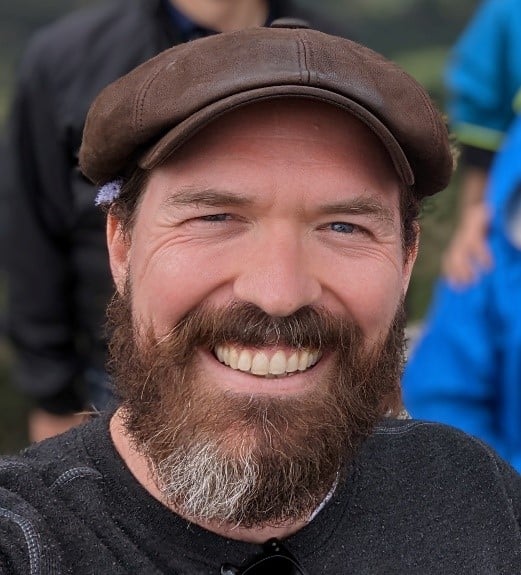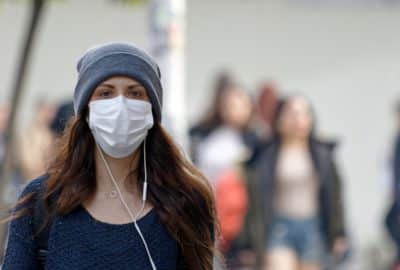How do you use social media to deliver humanitarian aid?
Wednesday 19th Apr 2023, 12.30pm
Forced displacement of human populations owing to conflict or natural disasters is very difficult to measure. During these crises, the traditional methods of assessing changes in populations – which mostly rely on surveys – are simply not possible. We chat to Dr Douglas Leasure from Oxford’s Leverhulme Centre for Demographic Science about how his team have been using social media data to assess the internal displacement of populations in Ukraine since the Russian invasion in February 2022, in order to help ensure humanitarian aid is delivered as effectively as possible.
If you would like to read the original research paper about Doug’s work, you can access it here: ‘Nowcasting Daily Population Displacement in Ukraine through Social Media Advertising Data‘.
You can find out more about the work of researchers at the Leverhulme Centre for Demographic Science in this Oxford Sparks micro-documentary: ‘Demography: Understanding Our World‘.
Emily Elias: On February 24th, 2022, Russia invaded Ukraine, and with that, a crisis began to unfold. The war meant millions were displaced from their homes, either leaving the country or seeking refuge somewhere else. And organisations need to figure out where to send aid.
On this episode of the Oxford Sparks Big Questions Podcast, we’re asking, “How do you use social media to deliver humanitarian aid?”
Hello, I’m Emily Elias, and this is the show where we seek out the brightest minds at the University of Oxford and we ask them the big questions. And for this one, we have found a researcher who’s trying to make sure aid gets to the right places.
Doug Leasure: My name is Doug Leasure, I’m a senior data scientist and researcher at the Leverhulme Centre for Demographic Science at the University of Oxford, and my research is focused on estimating populations in places where there’s not very much data available.
Emily: Okay. So can you take me back in time then to about February, 2022? What was going on with your research? What were you looking at?
Doug: Sure. So, at the time, I was very happily working with Professor Ridhi Kashyap on a project called Digital Gender Gaps, and that work was measuring the gender gap in internet access and usage.
So the difference between women and men, using the internet for countries globally, and we were measuring that gender gap using social media data. So we use targeted advertising data from social media to get counts of daily active users by men and women for every country globally. And we can use that to estimate differences in usage of the internet.
Emily: Okay, so February 24th, 2022 comes around. What was going on?
Doug: I opened my phone to see the headline that the Russian military had invaded Ukraine, and I immediately started thinking that the data that we had been collecting from social media might be useful for estimating changes in population and flows of displaced people.
Emily: Why would that be the case?
Doug: Well, migration in general, but forced displacement of populations due to conflict is inherently very difficult to measure because the traditional methods rely on doing surveys. So sending people out into the field to knock on doors and ask people questions about where they have recently moved from and why.
But social media and targeted advertising collect some information at the aggregate level, so information about large groups of people and their activity on Facebook or other social media platforms. So in this case, we were able to very quickly start collecting information about counts of daily active users on Facebook for Oblasts in Ukraine. And an Oblast is like a subnational administrative unit, so like a state or a county, and to get those counts of active users broken down by five-year age groups and sex; so men and women.
So on February 24th, 2022, when the Russian invasion began, we started collecting the social media data right away and I very quickly realised that I needed help to be able to analyse this data quickly enough to be relevant.
And so I sent a Slack message out to our research team, at 9:30am on a Sunday morning, feeling very guilty about doing that. And within four minutes I had, not just one response, but 20 responses from people who wanted to help without all of these people getting involved and dropping what they were doing to help develop these methods and analyse this data, there’s no way that this could have happened.
And so it really took teamwork from a group of dedicated researchers who wanted to do research that made a difference, that made this, kind of, a rapid response research project, possible. We’re able to collect that information every day, starting on February 25th, the day after the Russian invasion began.
Emily: And so what were you able to then tell from this data?
Doug: So first, our goal was very simple. It was just to measure changes in the number of active users to see if that might be useful indications for trends, for flows of people across Ukraine, fleeing the conflict and also internationally leaving Ukraine and coming to Europe and other countries.
But after reaching out to the United Nations and other humanitarian groups who were ramping up their response to support vulnerable, displaced populations in Ukraine, it became really clear to us that there was a big data gap that we wanted to help fill. So there was information about the number of people crossing the Ukrainian border to leave the country, but there was very little information about where people were inside Ukraine.
So we wanted to develop methods to use these counts of daily active users on Facebook and other social media platforms to estimate population sizes in five year age groups for men and women every single day inside Ukraine. And the overall goal was to measure how many people had been displaced from their homes and where they currently were to help send appropriate resources to those locations.
Emily: So what were your conversations like with humanitarian groups and the people at the UN when you approached them and said, “Hey, I think we can do this?”
Doug: So the initial response was that there was very little data available and they were very open to hearing ideas about non-traditional types of data that we might be able to use.
But rightly so, there was also some scepticism about how useful information from social media might be, and this scepticism is justified because we are getting counts of active users on Facebook, but this is very clearly a biased sample.
So this only includes people who are using Facebook. It doesn’t include people who do not use social media. So, for example, older populations use social media less. Populations living in urban canters tend to use social media more.
And then in eastern Ukraine where the conflict was the worst and still is the worst, Russian speaking populations there use Facebook at a very low rate.
So the concern was that this is not a representative sample of the population and so we need to work to address that.
Emily: So how did you guys do that? What was the workaround?
Doug: We used a few pieces of information to complete the puzzle. The first piece of information was looking at the percentage of the population before the Russian invasion who used Facebook. And we can do this in a very detailed way. We can look at subnational locations and by five year age groups for men and women, and measure what percentage, for example, of women between the ages of 30 and 34 who live in the city of Kyiv were active on Facebook before the Russian invasion.
That is one key piece of information to solve the puzzle. The other piece is information about the number of people who are leaving and entering Ukraine each day, and we were able to get this information from the United Nations. So this lets us know the total number of people in the country every single day. By combining these pieces of information through mathematics, we can estimate the total number of people, both who are using Facebook and who are not using Facebook for five year age/sex groups for each of these subnational locations inside Ukraine.
Emily: So numbers-wise, I mean, how many people are we talking about when it comes to looking at people that were displaced as a result of the conflict?
Doug: So a couple of weeks after the Russian invasion, the official estimate of internally displaced people was about 1.6 million, and this was an estimate from the International Organization for Migration at the United Nations who we were working directly with on this project.
At about three weeks after the invasion, we had developed our method and had come up with an estimate that was about five and a half million people internally displaced, which was way higher than the official estimates at the time.
And it turned out that the International Organization for Migration had also just completed a telephone survey of 2,000 people inside Ukraine to estimate displaced people. And their estimate was just over 6 million internally displaced. So with these two data sources together, both with their imperfections it’s, kind of, like going to another doctor to get a second opinion.
We now had two pieces of information that were giving similar estimates, and this contributed to the United Nations revising their official estimates of internally displaced persons to about 6.5 million people in mid-March, which really brought the full scope of the displacement crisis into clear view.
Emily: And I guess when it comes to then getting things like food and medical supplies to 1.6 million people, looks very different to getting it to five times that.
Doug: Yeah, that’s absolutely correct. And what we were trying to do was provide specific locations inside Ukraine and age groups at those locations because the types of aid that are relevant for these different age groups depends on where they’re located and what their demographics are.
Emily: How did it feel knowing that you were able to put all this information together and digestively give it to these organisations that needed it?
Doug: It felt very good. So for me as a researcher and for our team as a team of researchers, it’s really a rare opportunity when we can very quickly respond to events on the ground to conduct research in a way that has the potential to make a difference right away.
So we’re often very methodically developing new approaches and analysing data with the intention of writing an academic paper. But in this case, we were able to be responsive in a short amount of time so that we were relevant and provide information that was desperately needed by the international humanitarian response.
It really was rewarding and felt great and still does. We’re still working to fill those data gaps where we can and very happy to be doing it.
Emily: Now, this is obviously one major international crisis. Could this, in theory, be applied to other catastrophes that happen?
Doug: It’s a very good question, and it’s a question that we are working very hard to answer.
I think the initial signs are very promising that this type of work could be generalised to guide humanitarian responses in other countries, both in response to armed conflict, but also in response to natural disasters. But there are a lot of challenges with doing that. So the main one being that in different countries, populations are using different social media platforms and combinations of social media platforms.
And so we are working with international partners to start exploring this possibility and to develop methods that can combine this type of new data from social media with traditional data sources, from household surveys and registries of displaced persons. We think that it’s in this combination of data that we can really develop a generalisable approach that could have global relevance.
And so I can’t give you a definitive answer right now, but we’re hopeful and we’re working with partners to try to define ways to use a similar approach in other countries.
Emily: It’s really incredible. You’ve managed to solve a problem that you didn’t know was a problem (Laughter) up until a couple years ago.
And to have actual real results that you can point to and say, “Hey, this works.”
Doug: It’s true, and I just want to say that- so we aren’t the first people or first research group to be working on this challenge. So we are building on research from brilliant people who have been studying migration using social media data in the past.
And this includes in population displacement contexts. So, for example, there was a really great study in Venezuela showing flows of migrants out of Venezuela during the 2018/2019 political and economic crisis there. And also a really great paper by Monica Alexander that was studying flows of people out of Puerto Rico after Hurricane Maria.
And so we took those ideas and built on them. And I think what we were able to do was put something together quickly so that we can provide information to the humanitarian response in real time. But I want to emphasise that that would not have been possible without all of the brilliant people and their excellent work that came before us.
Emily: This podcast was brought to you by Oxford Sparks from the University of Oxford, with music by John Lyons, and a special thanks to Doug Leasure. Tell us what you think about this podcast, you can find us on social media. We are @OxfordSparks, and we’ve got a website, Oxfordsparks.ox.ac.uk.
I’m Emily Elias. Bye for now.
Transcribed by UK Transcription.




